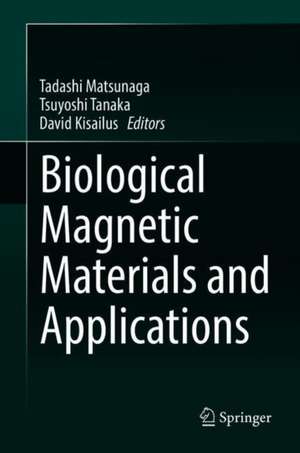Biological Magnetic Materials and Applications
Editat de Tadashi Matsunaga, Tsuyoshi Tanaka, David Kisailusen Limba Engleză Hardback – 25 iul 2018
In addition, the book discusses the recent industrial use of magnetic materials to develop scalable technologies that encompass protein displays, drug-delivery, biophysical separations, and medical diagnostics, as well as outlining future next-generation applications. As such, it offers valuable insights for all scientists interested in using multidisciplinary fields to overcome current obstacles, and in gaining multifaceted expertise in magnetic materials bionanotechnology.
| Toate formatele și edițiile | Preț | Express |
|---|---|---|
| Paperback (1) | 575.44 lei 39-44 zile | |
| Springer Nature Singapore – 21 dec 2018 | 575.44 lei 39-44 zile | |
| Hardback (1) | 793.07 lei 39-44 zile | |
| Springer Nature Singapore – 25 iul 2018 | 793.07 lei 39-44 zile |
Preț: 793.07 lei
Preț vechi: 1043.51 lei
-24% Nou
Puncte Express: 1190
Preț estimativ în valută:
151.76€ • 157.42$ • 126.54£
151.76€ • 157.42$ • 126.54£
Carte tipărită la comandă
Livrare economică 24-29 martie
Preluare comenzi: 021 569.72.76
Specificații
ISBN-13: 9789811080685
ISBN-10: 9811080682
Pagini: 260
Ilustrații: VIII, 199 p. 79 illus., 47 illus. in color.
Dimensiuni: 155 x 235 mm
Greutate: 0.56 kg
Ediția:1st ed. 2018
Editura: Springer Nature Singapore
Colecția Springer
Locul publicării:Singapore, Singapore
ISBN-10: 9811080682
Pagini: 260
Ilustrații: VIII, 199 p. 79 illus., 47 illus. in color.
Dimensiuni: 155 x 235 mm
Greutate: 0.56 kg
Ediția:1st ed. 2018
Editura: Springer Nature Singapore
Colecția Springer
Locul publicării:Singapore, Singapore
Cuprins
I-Formation mechanisms of biological magnetic materials.- Structure and function of aligned magnetic crystals in magnetotactic bacteria.- Molecular mechanism of magnetic crystal formation in magnetotactic bacteria.- Structural and proteomic analyses of iron oxide biomineralization in chiton teeth.- II-Biological templating of magnetic materials for medical and device applications.- Bioengineering and biotechnological applications of bacterial magnetic particles.- Peptide mediated synthesis of magnetic nanoparticle arrays as recording media.- Fabrication of nanodevices using nanoparticles synthesized in ferritin.- III-Bio-inspired magnetic materials for nanotechnology-based applications.- Bio-inspired synthesis of hierarchical structured iron compounds for batteries.- Bio-polymer directed magnetic composites.
Notă biografică
Editors:
Tadashi Matsunaga, Ph.D., President, Tokyo University of Agriculture and Technology, Fuchu, Tokyo, Japan
Tsuyoshi Tanaka, Ph.D., Professor, Division of Biotechnology and Life Science, Institute of Engineering, Tokyo University of Agriculture and Technology, Koganei, Tokyo, Japan
David Kisailus, Ph.D., Professor, Department of Chemical and Environmental Engineering, University of California,
Textul de pe ultima copertă
This book addresses the biologically controlled synthesis of magnetic materials, and its applications in bio-inspired design and synthesis. It highlights several key aspects of biologically produced magnetic materials – (i) organisms that biologically synthesize and utilize magnetic materials; (ii) formation mechanisms; (iii) how these biological formation routes yield various phases and morphologies; and (iv) the resultant magnetic and structural properties – and describes diverse bio-inspired approaches to utilizing magnetic materials in applications ranging from semiconductor to health industries.
In addition, the book discusses the recent industrial use of magnetic materials to develop scalable technologies that encompass protein displays, drug-delivery, biophysical separations, and medical diagnostics, as well as outlining future next-generation applications. As such, it offers valuable insights for all scientists interested in using multidisciplinary fields to overcome current obstacles, and in gaining multifaceted expertise in magnetic materials bionanotechnology.
In addition, the book discusses the recent industrial use of magnetic materials to develop scalable technologies that encompass protein displays, drug-delivery, biophysical separations, and medical diagnostics, as well as outlining future next-generation applications. As such, it offers valuable insights for all scientists interested in using multidisciplinary fields to overcome current obstacles, and in gaining multifaceted expertise in magnetic materials bionanotechnology.
Caracteristici
Provides a natural perspective on synthesis of engineered materials Pursues a cradle-to-grave approach, from biological processing to application Offers unique insights into processing next-generation materials
